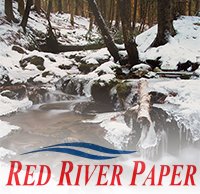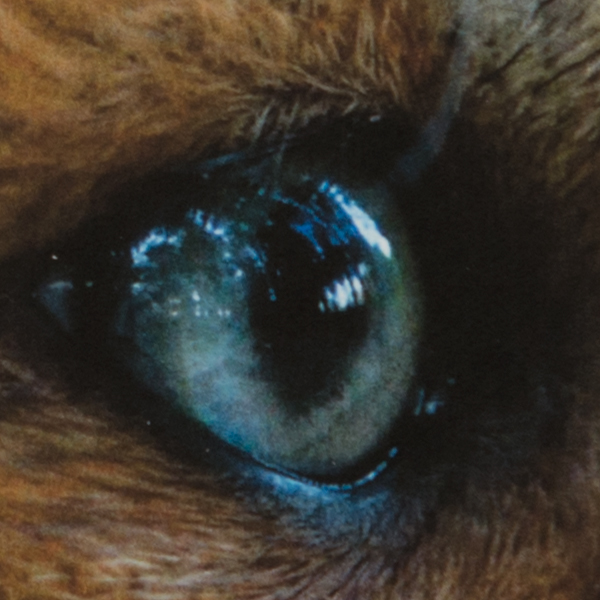Need quality, affordable paper for your new printer? Read our Red River Paper review!
posted Thursday, January 7, 2016 at 10:51 PM EDT

Along with a greeting card sample pack, Red River Paper also sent me a fine art sample kit and a variety of larger paper sizes to try out. During the course of my Epson P800 review, I tested out the papers that Red River sent me and came away very impressed.
First, a bit of background information on Red River Paper and what makes them different. Founded in 1997 in Texas, they buy their paper in large rolls directly from mills around the world, bring it to their facility in Dallas, Texas, and cut it into 14 different sizes. Depending on the papers, they also add their own treatment and special touch. They sell over 30 different kinds of paper directly to the consumer, which leads to reduced prices for the end-user.
Red River sent me the following papers in sizes ranging from 11 x 14" to 17 x 25": 75 lb. Arctic Polar Luster, Aurora Art White, 66 lb. Palo Duro Satin, and Palo Duro SoftGloss Rag. In addition to these papers, I also tested a wide variety of 8.5 x 11" sheets as part of Red River's 17+ paper Inkjet Photo and Fine Art Sample Kit which can be purchased for $12.99 and will give you a taste of many great papers. You can also add a Specialty Sampler for $5.99 which includes heavier papers such as the Palo Duro SoftGloss Rag that I tested in the 17 x 25" size and a Lightweight Paper sampler that is available for $3.99.
While all of the papers are high-quality and have useful applications, a few of the papers from the sample kit stood out in particular. (For a full list of the included papers, see here). Aurora Art Natural, a fine art acid-free paper with a semi-smooth surface impressed me. It has a "natural white tone" and no optical brighteners, which allows the paper to remain a consistent shade for a long time. Its natural white tone gives your images a warmth you don't typically find with other papers, which is great for some applications, although not ideal for neutral black and white prints.

Another two standouts from the sampler were two glossy papers. 66lb. Polar Pearl Metallic looked great and is one of the more impressive glossy papers I’ve printed on. It has excellent gloss uniformity and very deep blacks. Similarly, 66lb. Arctic Polar Gloss delivers great glossy results. The latter paper is slightly smoother and brighter.

I also printed on the 66lb. Arctic Polar Satin and 75 lb. Arctic Polar Luster papers. The former does an excellent job of replicating photo lab paper and provides deep blacks and vibrant colors. The latter has a slightly more textured finish (the E-Surface of the luster paper is 'deep' whereas the satin has a 'shallow' surface depth) and it also provides deep blacks and vibrant colors. What impressed me the most about both of these papers is their even gloss differential; the papers are both very even in their reflectivity, even when dealing with prints with bright whites.

The Aurora Art White paper that I received was a unique 12 x 12" size. This double-sided paper was slightly disappointing for me. It has a semi-smooth surface, bright white color, and is a 100% cotton rag base stock that is both acid- and lignin-free. It's 13.5mil thick and has a durable feel, but it just didn't produce high-quality prints. Whereas the other papers I tested all held up well against their Epson comparables, where applicable, this paper just didn't deliver the same great results I get with Epson's Hot Press Bright paper. My issues with the prints were a general lack of contrast, banding, and rough tonal transitions. I was using the second version of Red River's ICC profile for the P800, so perhaps a newer profile is in the works that will yield better results.

Of the other three papers that I tested in larger sizes, my favorite was the Palo Duro SoftGloss Rag paper, which was only recently released. This 100% cotton rag paper provides a "classic darkroom look" and "modern inkjet performance." The paper has a lightly textured, soft gloss surface that is simply stunning and it "reminds many of the traditional F-type print."
The Palo Duro SoftGloss Rag is true white, conservation grade paper (its base and coating are both acid-free) and it has no optical brighteners. It is a fairly thick paper at 16.5mil and with a weight of 310gsm, it's heavy-duty too. Even using the 17 x 25" sheets that I was sent (a very useful paper size, by the way, for making 16 x 24" prints), the paper felt sturdy when loading it into the printer.

With its fairly subtle gloss finish and lack of any logos on the back (thank you, Red River), this is a versatile paper that I am looking forward to integrating into my personal workflow. It worked well with both color and black and white images, proving to render deep blacks and bright, accurate colors. Tones were accurate and smooth and details were fine. The Palo Duro SoftGloss Rag proved to combine excellent performance with a very reasonable price ($3.72/sheet for 17 x 22" sheets).

Similarly impressive, although not quite as heavy-duty as the Palo Duro SoftGloss Rag, the Palo Duro Satin paper proved to be a solid, lab-style paper. Whereas many manufacturers are looking to make the most neutral and brightest papers they can, Red River has opted for a warmer look with this paper, which I like.

This paper doesn't have the same conservation quality as the SoftGloss Rag because its coating is slightly acidic, but it uses an acid-free base and also doesn't have any markings on the back of the paper. At 10.4mil thick and 255gsm weight, it's a fairly sturdy "photobase" paper that feels nice to use. Prints on this paper have very deep blacks and vibrant colors and this paper is also impressive for its value. If you're looking for 13 x 19" sheets, which costs $1.29/sheet from Red River, the comparable Epson paper costs about $1 more per sheet when bought directly from Epson and the comparable Canon paper costs about $0.70 more per sheet when purchased directly. You're receiving high-end performance and quality at a significantly lower price.
All in all, my first experiences with Red River Paper's offerings were very positive. Their wide selection of paper offers something for everyone, and their high-end offerings such as the Palo Duro SoftGloss Rag prove to be up to the task of challenging the big players in the industry in quality and often at lower costs.
Red River Paper
(Note: All images of prints in this review were captured using a Nikon D800e and Nikon 60mm f/2.8G macro lens. RAW files were converted using default settings in Adobe Camera RAW and no other sharpening or adjustments have been made. Automatic white balance was used. Further, +0.7 exposure compensation was used to achieve the approximate appearance of the print in natural daylight.)